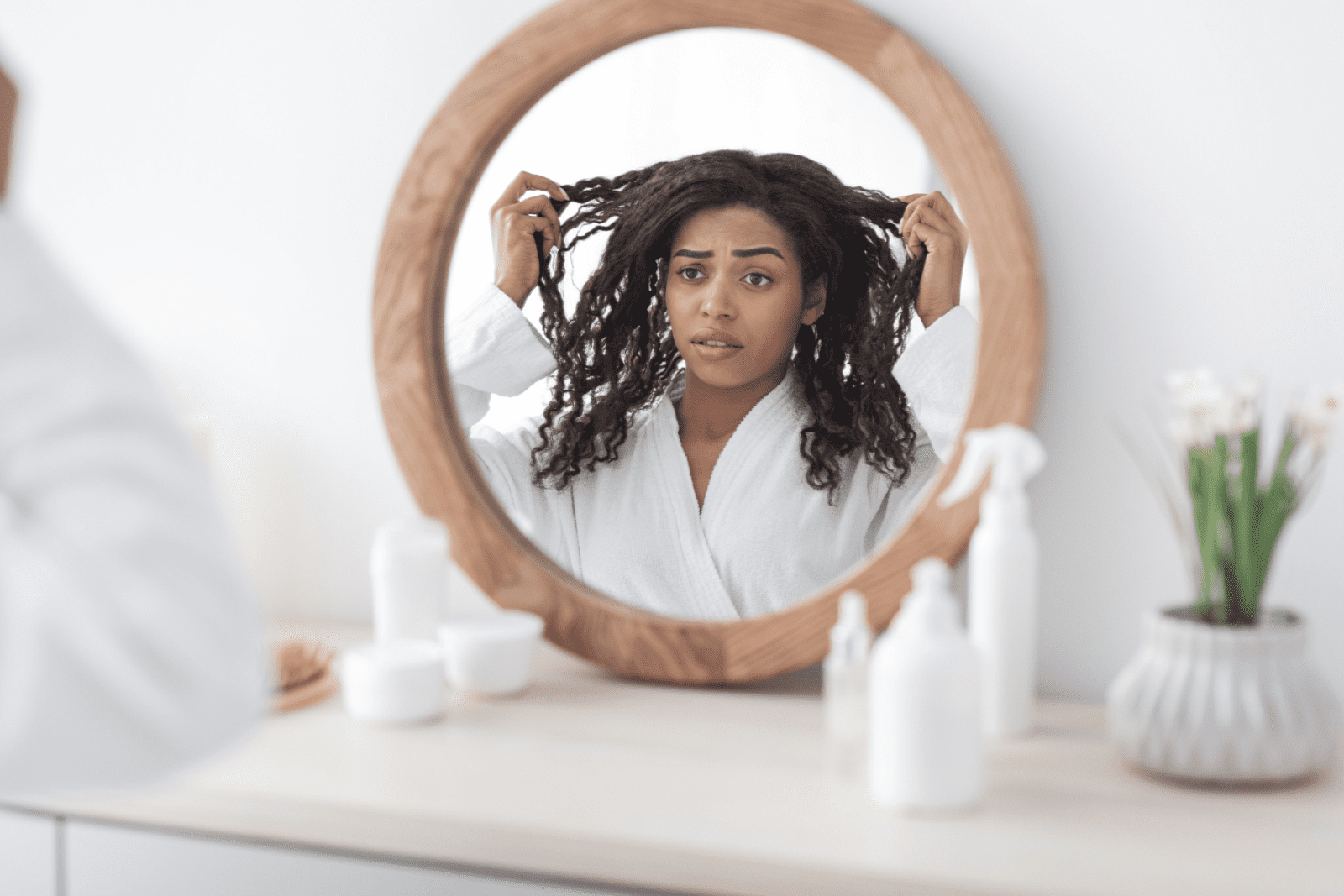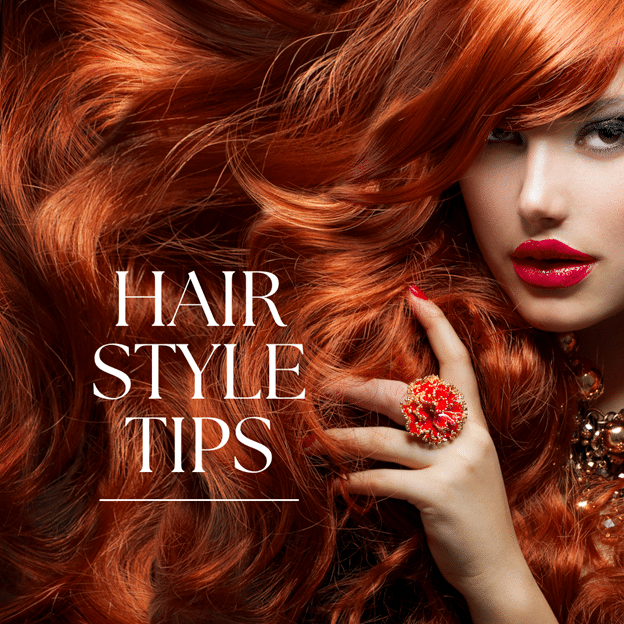
Common curly hair problems plague all of us. Curly hair can be both a blessing and a challenge, with its unique structure requiring special care and attention. This post will explain how to fix common curly hair problems at home. When dealing with common issues like frizz, dryness, or limpness, implementing simple yet effective techniques can make a significant difference in how your curls look and feel.
Understanding the best methods for taming curly hair starts with your routine, from washing to styling. Using tools and products that cater to the texture and shape of your curls can dramatically improve your hair’s health and appearance. For instance, applying products to wet hair enhances the curls and prevents frizz. This allows your styling products to seal in moisture, leading to more defined curls. Similarly, replacing terrycloth towels with microfiber towels or T-shirts reduces frizz caused by rough fabric.
Creating a regimen tailored to your curl type is essential for maintaining lively and bouncy hair. Whether you’re combating dryness, dealing with flatness, or looking for better styling techniques, adopting a consistent routine can yield transformative results. Using a diffuser for drying and a curl enhancer like a mousse or gel can help maximize definition and minimize styling woes.
Understanding Curly Hair
Curly hair is diverse and comes with its unique characteristics and challenges. By knowing the types and common issues associated with curly hair, you can better care for and fix common curly hair problems at home.
Types of Curly Hair
Curly hair is typically categorized into four main types based on its curl pattern and texture. Type 2 hair is wavy, with an S-pattern that ranges from loose waves to more defined loops. Type 3 hair is curly, featuring spiraled curls that vary from loose coils to tight corkscrews. Type 4 hair is characterized by extremely tight, coil-like curls that often form a zig-zag pattern. Understanding the specific type can help you tailor your hair care routine to meet your curls’ needs and fix common curly hair problems at home.
Common Curly Hair Problems
Curly hair tends to be drier than straight hair because its natural oils have a harder time traveling down the coil. This can lead to frizz, breakage, and limp curls. Using the wrong type of towel, like terrycloth, can agitate your hair cuticles, causing tangling and excess water absorption. Avoid brushing dry hair to prevent additional frizz and breakage. Regular deep conditioning is essential to provide the moisture curly hair lacks, ensuring your curls stay hydrated and vibrant. Protecting your curls from excessive heat and UV rays can help preserve their natural texture and health.
Washing and Conditioning
Mastering the right techniques for washing and conditioning curly hair is crucial to ensure it remains healthy and vibrant. By focusing on proper shampoo methods, deep conditioning, and effective detangling, you can manage common curly hair issues effectively and fix common curly hair problems at home.
Proper Shampoo Techniques
When shampooing curly hair, it is important to focus on the scalp rather than the ends. Use a mild shampoo to avoid stripping the hair of its natural oils. Apply shampoo to your roots only and gently massage it in to remove dirt and excess oil.
Add a little water to help the shampoo lather, then rinse thoroughly. The foam should lightly cleanse the ends as it rinses out. It is typically unnecessary to apply shampoo directly to the lengths of your hair.
Shampooing every few days is sufficient, as frequent washing can lead to dryness. Consider co-washing or water-only rinses on non-shampoo days to retain moisture and maintain the hair’s natural balance.
Deep Conditioning Routines
Deep conditioning is essential for curly hair’s moisture and elasticity. Use a rich, hydrating conditioner after every wash to keep curls soft and manageable. Focus on the ends, which tend to be drier than the roots.
For an intensive treatment, apply a deep moisture mask or treatment once a week. Leave it in for at least 10-30 minutes, allowing the nourishing ingredients to penetrate deeply. Heat caps or warm towels can enhance the effectiveness of the treatment.
Rinse with cool water to seal the hair cuticle, locking in moisture and shine. Adjust the frequency of deep conditioning based on your hair’s needs and the season’s humidity levels.
Detangling Methods
Detangling curly hair requires care to avoid breakage and reduce frizz. Start by wetting your hair thoroughly and applying a generous amount of leave-in conditioner. This provides slip, making it easier to detangle.
Use a wide-toothed comb or a detangling brush, starting from the ends and working upwards in sections. This method minimizes tugging on the roots and reduces damage. Finger detangling is another gentle option that can help maintain the hair’s natural curl pattern.
Avoid detangling dry hair, as this can lead to breakage. If needed, rehydrate with a spray bottle of water or leave-in conditioner before attempting to detangle.
Moisturizing and Sealing
Maintaining adequate moisture in curly hair involves using suitable products followed by an effective sealing technique. This ensures that your curls remain vibrant and healthy while minimizing the common problem of dryness.
Choosing the Right Products
Selecting appropriate haircare products is essential for keeping curly hair adequately hydrated. Opt for products specially formulated to moisturize without adding unnecessary weight. Look for key ingredients like glycerin, aloe vera, and natural oils that promote hydration.
Avoid products with harsh sulfates and alcohols, as these can further dry out your curls. Instead, choose sulfate-free shampoos and conditioners that offer gentle cleansing and deep conditioning properties.
Regularly use a leave-in conditioner to help retain moisture throughout the day. In addition, a curl cream can enhance your natural curl pattern and provide an extra moisture boost. Consider exploring comprehensive options at Curly Hair Products for tailored solutions to help you fix common curly hair problems at home.
Sealing in Moisture
Once you’ve moisturized your hair, it’s crucial to seal in that moisture to prevent it from escaping. The best way to do this is by applying a natural oil after your leave-in conditioner. Oils such as argan, jojoba, or coconut form a protective barrier over the hair shaft.
Remember to apply the oil evenly, focusing especially on the ends of your hair, which are more prone to dryness. This sealing step not only locks in moisture but also provides a beautiful sheen and enhanced protection against environmental factors.
For heightened results, use a light touch to ensure definition without overloading the curls. Keeping a consistent routine will help maintain healthy, hydrated curls.
Styling and Maintenance
To maintain the health and appearance of curly hair, focus on protective styles, routines for refreshing your curls, and using hair-friendly silk elastics. These methods help reduce breakage, minimize frizz, and keep curls looking their best.
Protective Styling
Protective styling is crucial for reducing damage and promoting hair health. Try styles like braids, twists, or buns to safeguard your curly hair. These styles shield your hair from environmental stressors and reduce the need for frequent manipulation.
Keep your hair moisturized by applying a leave-in conditioner before styling. Use satin or silk accessories to minimize friction. Incorporate protective styles into your routine, especially during harsh weather conditions.
Apply a lightweight oil like argan or jojoba for added protection and shine. Avoid tight hairstyles that can cause tension and lead to hair damage. Reducing the strain on your hair can significantly improve its resilience and reduce breakage over time.
Refresh Routines to Fix Common Curly Hair Problems
Refresh routines are essential for keeping curls vibrant between wash days. Start with a light misting of water or a curl refresher spray to reactivate your curls. Apply a small amount of conditioner or a curling cream to redefine and hydrate the curls.
Use your fingers or a wide-tooth comb to gently detangle. For a boost of volume, consider using a hairdryer on a low setting with a diffuser attachment. Don’t overuse styling products, as they can cause buildup and weigh curls down.
Experiment with different refreshing techniques, such as scrunching, to find out what works best for your hair type. Incorporate these techniques into your daily routine to maintain your hairstyle effortlessly.
Safe Hair Elastics
Using the right hair elastics is vital to prevent breakage and maintain hair health. Choose elastic bands that are free of metal clasps to avoid damaging your hair. Opt for fabric-covered elastics or spiral hair ties that are kinder to the hair cuticle.
Avoid excessively tight ponytails or buns which can strain your hair. Consider swapping traditional elastics for satin or silk scrunchies, which offer a more gentle hold. They help reduce friction and maintain the curl pattern.
Make sure to replace your hair elastics regularly. Overused or stretched-out elastics can lose their effectiveness and have the potential to snag hair, leading to unwanted breakage.
Dealing With Damage
Curly hair can easily become damaged due to various factors like heat styling, split ends, and color treatments. Addressing these issues requires specific care routines and techniques to restore your hair’s health and vitality.
Repairing Heat Damage
To combat heat damage, reducing the use of heat-styling tools is essential. Opt for air drying or setting tools to a low heat level. Always apply a heat protectant spray before using any styling tools. Incorporating a weekly deep conditioning treatment can also help restore moisture and elasticity to your curls.
Another effective approach is using protein treatments. They strengthen hair strands and aid in reviving natural curl patterns. This should be done about once every four to six weeks. Following these steps consistently can lead to noticeable improvement in your hair’s texture and resilience.
Split Ends Remedies
Regular trims are crucial in handling split ends. Aim to visit your stylist every six to eight weeks to prevent splits from advancing along the hair shaft. Meanwhile, minimize any mechanical stress such as excessive brushing or towel drying that can exacerbate the issue.
Utilize nourishing leave-in conditioners and high-quality hair oils that contain vitamins and fatty acids. These products help to smooth the ends and temporarily bond split fibers, giving your hair a healthier look between trims. Consider incorporating silk or satin pillowcases to lessen friction when sleeping, further protecting your curls.
Color-Treated Hair Care
Color-treated curls require specialized attention to maintain vibrancy and prevent further damage. Use shampoos and conditioners specifically designed for color-treated hair. These products contain ingredients that protect against color fade and offer extra hydration.
It’s important to steer clear of harsh chemicals and alcohol-based products. Weekly deep conditioning masks help in maintaining moisture balance and extending the life of your color. Additionally, avoid prolonged sun exposure whenever possible. If needed, wear a hat or use hair products with UV protection to shield your hair from further damage.
Curly Hair and Scalp Health
Ensuring both your curly hair and scalp are healthy involves specific care methods to address common issues like dryness and dandruff. The right treatments can make a significant difference in maintaining scalp moisture and preventing flakes.
Scalp Treatments
Maintaining a healthy scalp is crucial for curly hair. You can use various treatments that cater to the unique needs of your scalp. Regularly massaging your scalp with oils such as coconut or jojoba can improve circulation and hydration. Incorporating essential oils like tea tree or lavender can further enhance the benefits by offering antimicrobial properties.
A weekly scalp exfoliation can also be beneficial. Use a gentle scrub or a clarifying shampoo to remove buildup. Be sure to moisturize afterward to prevent dryness. Avoid over-washing, as this can strip essential oils.
Dandruff Solutions
Dandruff can be a frustrating issue but can be managed with the right approach. Choosing a dandruff shampoo containing ingredients like zinc pyrithione or selenium sulfide can help control flakes. Apply the shampoo to your scalp and leave it in for several minutes for maximum effectiveness before rinsing thoroughly.
In addition to specialized shampoos, maintaining a balanced scalp pH with occasional apple cider vinegar rinses can help reduce dandruff. Dilute one part vinegar to two parts water. A balanced diet rich in omega-3 fatty acids and zinc can also support scalp health.
Product Buildup and Cleansing to Fix Common Curly Hair Problems
Curly hair is susceptible to product buildup, which can make it look dull and lifeless. It’s essential to establish an effective cleansing routine and avoid overloading your hair with excessive products to maintain its health and vitality.
Clarifying Routines
Product buildup occurs when residue from styling products accumulates on your hair and scalp. To address this, incorporating a clarifying routine can significantly improve your curls’ appearance. Clarifying shampoos are designed to deeply cleanse and remove residues from your hair. Use them sparingly, about once or twice a month, to prevent excessive dryness.

Natural alternatives such as apple cider vinegar rinses or baking soda pastes can also be effective. Mix equal parts of apple cider vinegar and water, apply to your hair, let it sit for a few minutes, and then rinse thoroughly. These methods help restore your hair’s natural shine and bounce without harsh chemicals.
Avoid Product Overload
To maintain healthy curls, it’s crucial to avoid overloading your hair with too many products. Start by identifying your hair’s needs and selecting products that cater specifically to those requirements.
Use minimal amounts and observe how your hair responds, adjusting as needed. Considering lightweight products or those specifically formulated for curly hair can help. Layering products strategically, like starting with a leave-in conditioner followed by a curl cream, ensures each product serves a specific purpose.
Finally, regular scalp massages can aid in the even distribution of products and assist in reducing buildup, promoting healthier curls.
Curly Hair Lifestyle
Maintaining healthy curls involves more than just using the right products. Your lifestyle has a significant impact on the health and appearance of your curly hair.
Impact of Stress on Curls
Stress can significantly affect your curly hair’s condition. It triggers hormonal changes that might lead to hair loss and dullness. Cortisol, the stress hormone, disrupts hair growth cycles.
Practicing stress management techniques can improve hair health. Activities such as meditation, yoga, and regular exercise can help keep stress in check.
Adequate sleep also plays a role in reducing stress impact. Aim for 7-9 hours per night to ensure your body’s overall well-being, which includes healthier hair.
Long-Term Care Strategies for Common Curly Hair Problems
Caring for curly hair requires a consistent approach to maintain its health and vitality. Incorporate these long-term strategies into your routine to keep your curls looking their best.
Hydration is Key
Ensure that your hair stays moisturized. Use a leave-in conditioner regularly and apply a deep conditioning treatment weekly to strengthen and nourish your curls.
Gentle Washing Practices
Wash your hair based on its needs, often every 2 to 3 weeks. Frequent washing can strip your hair of essential oils, leading to dryness and frizz.
Air-Dry Over Heat
Limit the use of heat-styling tools to prevent damage. If you need to dry your hair quickly, choose a diffuser and set it on a low heat setting. Air-drying is gentler on your curls and encourages natural texture.
Detangle with Care to avoid common curly hair problems
Use a wide-tooth comb or your fingers to detangle. Start from the ends, working your way up to prevent breakage. Apply a bit of conditioner or a detangling product to ease the process.
Protective Styles
Opt for protective hairstyles like braids or twists to reduce exposure to environmental factors. These styles can help prevent breakage and maintain moisture.
Regular Trims
Schedule regular haircuts every 8 to 12 weeks to eliminate split ends and promote healthy growth. Staying on top of trims keeps your curls looking fresh and bouncy.
Adjust your hair care routine as needed based on your individual hair’s response and changing seasons to ensure your curls remain vibrant and healthy. We hope this guide has shown you how to fix common curly hair problems.
Also read: What is Type 3 Hair, and What is the Best Way to Care for It?
Check out our yearly membership to gain access to ALL of the Ultimate Guides, templates, and MUCH MORE. Click HERE.






